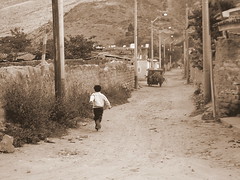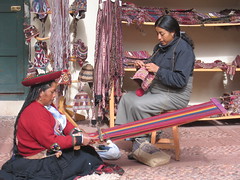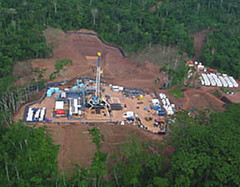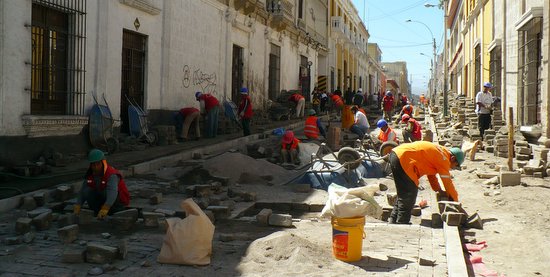Aguas Calientes often calls itself Machu Picchu Pueblo as its sole purpose is to be a base from which to visit the Machu Picchu ruins on the nearby Machu Picchu mountain.
Category: "Travel and Places"
Pisac – the market town
We arrived in Pisac to see the ruins, town and market. Unfortunately after spending the night here we had to return to Cusco to buy our tickets to Machu Picchu.
The journey here from Cusco was cheap and easy, a little over S./2 each on a local bus, and it takes no more than 45 minutes. We took a similar bus back to Cusco, bought the tickets from the guy who wouldn’t sell them to us the day before, and the bus back to Pisaq again. This took no more than a couple of hours with a added stop in plaza Rimaq-Pampa to use the internet. Within no time we were back in Pisaq.
Puka Pukará
This small set of ruins sits on a hilltop. It is assumed it was a fort as it commands views of the entire area and its name in Quechua means “Red Fort”. It isn’t as simple as that though as the place is quite small. Perhaps it was more of a guard post.
There are numerous storage areas for storing grain and cereals, it also has some places to sleep.
Sacsayhuamán
Pachacútec, expander of the empire, ordered the site’s construction in the mid-1400’s. The complex took almost 100 years to complete with thousands of men. Many of the blocks were taken from as far as 32km away. Some blocks are the size of large buses and weigh hundreds of tons. No-one knows how they managed to move them, not even how they managed to cut the bricks with laser-precision. All that survives of the place is what the Spanish weren’t able to destroy – what they didn’t have the technology to destroy. What you see in my photos is a mere 20% of what once stood here.
Qoricancha – Templo del Sol
The Temple of the Sun, mostly destroyed by a Dominican church built on top, is a prime example of the clash of cultures that took place; and who dominated who.
Qoricancha was a monumental building, several blocks away from the main square of the Inca city. It was where the highest priests in the empire were based…
Pachacutec
Pachacutec was the Inca emperor who turned Cuzco from a city state to an empire that spanned from Ecuador to Chile. At one end of the Av. El Sol is a gigantic statue of him that you can visit and climb.
Cusco’s Monasterio de Santa Catalina
This monastery was finished in 1610 and built on top of the destroyed Inca ruins of Acllawasi. This monastery is famous for its colonial religious art, particularly its collection of the Escuela Cusqueña paintings. These are some of the greatest works of Amerindian art in Cuzco – a mix of taught European styles with indigenous influences.
Quechua street names
It’s nice to walk around Cusco and see street names in the Quechua language, the language of the Incas. These two are particularly fun to pronounce.
Inca Q’osco
The Inca city of Q’osco was large even by our standards, with numerous grand palaces, public buildings and temples. Despite their hate for the un-Godly yet vastly superior architecture, the Spanish couldn’t destroy all of it and much is still highly visible as the bottom half of almost all colonial buildings. Inca temples now prop up grand baroque churches and Inca palaces were turned into the foundations of colonial mansions.
Streets of Cusco
A photo tour of the streets of Cusco.
God now charges by the hour
I knew something was up when several metres in front of us I saw two tourists approach Cuzco’s grand cathedral, speak with a couple of guys blocking the door, then walk away disappointed. Perhaps it was closed to tourists today?
It turns out that if you want to enter the cathedral and look around, something I do in every city in Peru and takes a few minutes, you have to pay S./16 per person. Only in Cuzco would you have to pay to enter a cathedral. But it doesn’t stop there. We tried to enter other churches that took our interest, many of which built by destroying Inca buildings to use the bricks or foundations. The story was the same, cough up huge sums of money or God is just not interested.
We couldn’t afford to enter the cathedral or any churches in Cuzco. Perhaps God will welcome us into his flock when we earn a higher salary.
Restaurant-Pizzería Arrieros
On our first morning in Cusco we left our hotel with the aim to find another one. The night before we had discovered that most hotels here give prices in US$ and that a two-star hostel in Cuzco costs the same as four star hotel elsewhere in the country. It was getting dark and we ended up sleeping at the cheapest two-star place we could find in our rush to get to sleep, S./50 a night, or about $17.
Looking for another one proved easy, the small family run restaurant we were in last night offered us a room for S./15 per person – and it was in San Blas, a fashionable district. It wasn’t getting any better than that in this city, so we returned and accepted the offer.





![Inti Raymi: Cultural Preservation or Capitalistic Exploitation? [Featured]](http://farm4.static.flickr.com/3337/3672238491_eb07fbe9eb_m.jpg)


![Ice cream culture in Peru [Featured]](http://anaperuana.com/wp-content/uploads/2009/03/blog_ice_cream_001.jpg)

